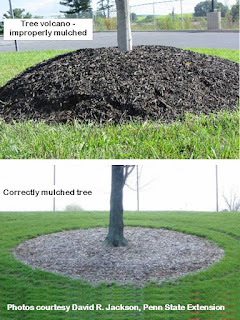[A NOTE from our Master Gardener Facebook page written by Annette MaCoy, Master Gardener Coordinator.]
This
spring, you may be spending more time at home and in your garden than you
expected. Perhaps you’ve decided that, along with the Victory Garden you’re
planting for fresh and healthy produce, you’d like to plant a tree in your
landscape for shade and beauty.
Many
local nurseries and garden centers are still open during the Covid-19 shutdown,
but before leaving home, be sure to call the business first to check on its
status and hours of operation, which may be limited or modified.
[Tim Abbey, Extension Education says "During my twenty-four year career, the most common tree problem that I encounter isn't an insect or a disease—it is us." See his tips for Successful Planting.]
Do
you know the right way to plant a tree? You might be surprised to find that
it’s not what you thought. Consider the following statements – true or false?

It pays to Plant with Care.
All these statements are false, and yet all are often repeated as time-honored tradition. Research as proven otherwise. If you want a tree to survive and thrive, follow these suggestions instead.
Smaller trees – up to about 6 feet in height or up to about 1-inch caliper – are much easier to transplant and will re-establish much more quickly than a larger tree in a small container, which is likely to have a very poor root system. A larger tree may suffer transplant shock for 5-10 years, during which time a smaller tree will have surpassed it in growth rate and size.
 |
| Use your shovel handle and lay it across the grade. (Photo: joegarden.com) |
Planting
Hole - Dig a shallow hole that is 2 to 5 times
wider than the root ball. You must find the root flare first; then dig the hole
only deep enough to position the root flare at or slightly above soil grade.
The root flare is that widening of the trunk at its base to join the roots; it
may be buried or hidden within the container mix or ball of soil. An easy way to know if your hole is at the right depth is to take your shovel handle and lay it across the grade. The top of the root ball or tree flare should be at or above the handle level. The root mass
should be resting on undisturbed soil, and your planting hole should be a wide,
shallow bowl, not a deep narrow cup.
Roots - Do give the roots a “bad hair day”! It is important to loosen and examine the roots of a container-grown or balled-and-burlapped tree before planting. Kinked, girdling, damaged, defective, and very long roots should be trimmed. This does not harm the plant; it will encourage the growth of healthy new roots and may prevent the future problems of a poor root system. When working with roots, always keep them moist and shaded. If possible, remove excess amounts of the container medium in which the tree was growing – whether it’s the soilless mix of a container or the heavy clay soil of a balled plant – to facilitate root contact with the backfill soil in the planting hole. All twine, and as much burlap and wire as possible, should be removed from a balled plant.
 |
| (Photo: Univ.Maryland) |
Soil
- In average garden soil, do not amend the backfill soil with organic
matter. Loosen it and break up large clumps before backfilling around the
roots. If the soil is extremely poor, mix up to 10% by volume of organic matter
into the backfill. Amending the backfill soil with copious amounts of organic
matter (compost, manure, or peat moss, for instance) changes its texture, which
makes it very difficult for the roots to grow beyond the planting hole. A
strong tree will have roots spreading outward into native soil, not circling
within amended backfill soil.
Mulch - Do not mound mulch up around the trunk of a tree. This is called a “mulch volcano,” and we all know that trees don’t grow in volcanoes. Mulch should be applied in a thin flat layer, 2 to 4 inches thick, spread over as much of the root zone under the tree’s canopy as you can manage, with an area left bare directly around the tree’s trunk. Mulch piled right against the trunk keeps the bark moist, which can lead to insect and disease problems; it also provides habitat for nibbling animals such as mice and voles, and can lead to girdling roots by interfering with oxygen and water absorption by the roots.
Pruning
- Newly planted trees should not be pruned to ‘balance’ the crown and
roots. The leaf canopy provides energy to the roots to help them begin growing.
Pruning stimulates the tree to expend energy on new top growth at the expense
of root growth. The only pruning that should be done at planting is to remove
broken, dead, or defective branches. Give roots at least one year to become
established before pruning the tree for structure.
Once
your tree is properly planted, continue to keep it watered (moist but not
saturated soil throughout the root zone) for at least the first year after
transplanting. These guidelines, more than any transplant potions or outdated
advice, will ensure a healthy tree for future generations.
~ Annette MaCoy, Penn State Extension, Franklin County
**********






No comments:
Post a Comment